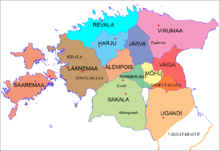Virumaa
Estonian
[edit]

Etymology
[edit]The origin of the first element is uncertain. A myriad of theories have been proposed, connecting it with the words veer (“edge”) (cf. Finnish vieru), virk (“diligent”) (although this is phonetically improbable), viir (“stripe”), virukas (“strong”)[1], viru (“whirlpool”) (see Võru) and a personal name (*Viiroi or *Viroi, according to Kettunen).[2][3] Mägiste considers this to be a diminutive of the word vire (“gusty (wind)”).[1]
Germanic or Baltic borrowings have also been widely theorized. Grünthal has studied the Baltic connections the most, comparing the term to Latvian vīrs and Lithuanian vyras (“man”) (gen. pl. vyrų; from Proto-Baltic *wī́ˀras), but points out the phonological inconsistency of the Proto-Baltic long *ī turning into a short i in Estonian.[4] That doesn't rule out the Baltic theory though, as the're might have been intermediary developments, which are not uncommon to encounter with toponyms. Furthermore, archeology seems to heavily indicate a Baltic borrowing: a disproportionate amount of bronze artifacts have been dug up, indicating this region's heavy trade with the Balts, and jewellery from this region has many Baltic characteristics, specifically from the Old Prussian-speaking region.[5] EES uncertainly proposes both Germanic and Baltic connections for the term virulane (which includes the suffix -lane).[6] Both Koivulehto and Grünthal have proposed an earlier borrowing from Proto-Indo-European *wiHrós (“man”), from which the Baltic terms originate, as well as the first element of Old Norse ver-ǫld (“world”) (from Proto-Germanic *weraz).[7][4][8] Curiously, the toponym has also been explained through Latin: Bartholomaeus Anglicus in the XIII century encyclopedia De proprietatibus rerum claimed with great confidence that the toponym originates from Latin viror (“greenness”), as the region was considered particularly fertile, green and free of any major castles.[9] If the Indo-European connection is true at all, the term must have been borrowed a very long time ago.[10]
Pronunciation
[edit]Proper noun
[edit]Virumaa (genitive Virumaa, partitive Virumaad)
- an ancient county located in northeastern Estonia
- (historical) A former county in northeastern Estonia, existed between 1918–1950
- Synonym: Viru maakond
Declension
[edit]| Declension of Virumaa (ÕS type 26i/idee, no gradation) | |||
|---|---|---|---|
| singular | plural | ||
| nominative | Virumaa | Virumaad | |
| accusative | nom. | ||
| gen. | Virumaa | ||
| genitive | Virumaade | ||
| partitive | Virumaad | Virumaid Virumaasid | |
| illative | Virumaasse | Virumaadesse Virumaisse | |
| inessive | Virumaas | Virumaades Virumais | |
| elative | Virumaast | Virumaadest Virumaist | |
| allative | Virumaale | Virumaadele Virumaile | |
| adessive | Virumaal | Virumaadel Virumail | |
| ablative | Virumaalt | Virumaadelt Virumailt | |
| translative | Virumaaks | Virumaadeks Virumaiks | |
| terminative | Virumaani | Virumaadeni | |
| essive | Virumaana | Virumaadena | |
| abessive | Virumaata | Virumaadeta | |
| comitative | Virumaaga | Virumaadega | |
Derived terms
[edit]References
[edit]- ↑ 1.0 1.1 Mägiste, Julius (1982) Estnisches etymologisches Wörterbuch (in German), volume XII, Helsinki: Finnisch-Ugrische Gesellschaft, page 3884
- ^ Kettunen, Lauri (1955) Etymologische Untersuchungen über estnische Ortsnamen (Suomalaisen Tiedeakatemian Toimituksia, Sarja B) (in German), volume 90, number 1, Helsinki, page 187
- ^ Mägiste, Julius (1928) oi̯-, ei̯-deminutiivid läänemeresoome keelis (Läänemeresoome nominaaltuletus; I)[1] (in Estonian), Tartu, page 197
- ↑ 4.0 4.1 Grünthal, Riho (1997) Livvistä liiviin. Itämerensuomalaiset etnonyymit (Castrenianumin toimitteita)[2] (in Finnish), volume 51, Helsinki: Suomalais-Ugrilainen Seura, →ISBN, pages 200–204
- ^ Lõugas, Vello (1978) “Kuidas Virumaa endale nime sai?”, in Horisont[3] (in Estonian), volume 11, number 7, →ISSN, pages 8–11
- ^ “virulane”, in [ETY] Eesti etümoloogiasõnaraamat [Estonian Etymological Dictionary] (in Estonian) (online version), Tallinn: Eesti Keele Sihtasutus (Estonian Language Foundation), 2012
- ^ Koivulehto, Jorma (1993) “Suomi”, in Virittäjä (in Finnish), volume 97, number 3, →ISSN, page 400
- ^ Ruppel, Klaas, editor (2021–2023), “Viro”, in Suomen etymologinen sanakirja [Finnish Etymological Dictionary] (Kotimaisten kielten keskuksen verkkojulkaisuja 72)[4] (in Finnish), Kotimaisten kielten keskus, →ISSN
- ^ Tamm, Marek (2014) “Kujuteldavad maastikud. Ida-Baltikum ja 13. sajandi Euroopa kultuuriline geograafia [Imagined Landscapes: The Eastern Baltic Region and the Cultural Geography of Thirteenth-Century Europe]”, in Linda Kaljundi, Helen Sooväli-Sepping, editors, Maastik ja mälu. Pärandiloome arengujooni Eestis (Acta Universitatis Tallinnensis. Socialia, 1736-941X) (in Estonian), Tallinn: University of Tallinn, →ISBN, page 90
- ^ “Virumaa”, in [KNR] Eesti kohanimeraamat [Book of Estonian Toponyms] (in Estonian) (online version, occasionally updated), Tallinn: Eesti Keele Sihtasutus (Estonian Language Foundation), 2017–
Further reading
[edit]- Estonian compound terms
- Estonian terms with unknown etymologies
- Estonian terms with IPA pronunciation
- Rhymes:Estonian/mɑː
- Rhymes:Estonian/mɑː/3 syllables
- Estonian lemmas
- Estonian proper nouns
- Estonian terms with historical senses
- et:Historical political subdivisions
- et:Places in Estonia
- Estonian idee-type nominals
